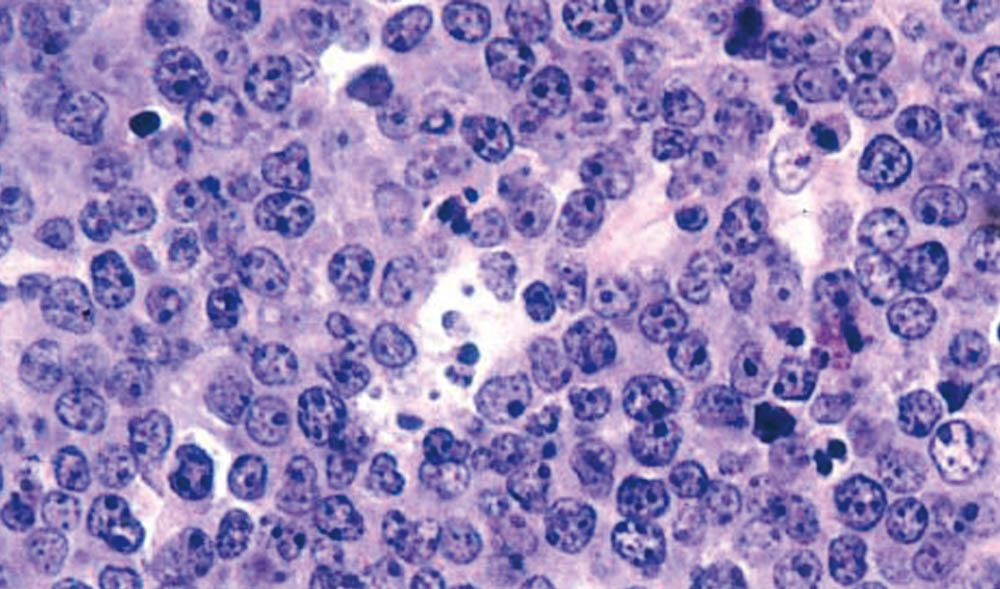SUMMARY: A rare form of non-Hodgkin lymphoma has few standard treatments, but a grant for laboratory and preclinical research has stimulated new focus on clinical trials.
Medically reviewed by David M. Weinstock, MD, and Eric Jacobsen, MD
By banding together to study the basic biology and vulnerabilities of T-cell lymphoma, scientists at several major cancer research centers have sparked a surge of clinical trials of promising treatments for the disease.
The string of new trials, some already open, some expected to open soon, some completed, represents a major thrust against a disease for which few standard therapies are available. A form of non-Hodgkin lymphoma (NHL), T-cell lymphoma occurs when immune system T cells begin growing and multiplying uncontrollably. There are numerous types of the disease, which together account for about 10% of NHL cases in the United States.
In 2015, spurred by the need for new approaches to treating T-cell lymphomas, Dana-Farber’s David Weinstock, MD, led researchers at several institutions in receiving a prestigious SCOR (Specialized Center of Research) grant from the Leukemia and Lymphoma Society to support collaborative research into the disease. The grant, awarded to scientists at Dana-Farber, Memorial Sloan Kettering Cancer Center, Weill Cornell Medical Center, Brigham and Women’s Hospital, and other institutions, has underwritten research in laboratory cell lines and animal models and set the stage for the wave of clinical research now underway.

“Recent studies have shown that certain targeted drugs can shrink some T-cell lymphomas. This created a unique opportunity to build new approaches for treating people with T-cell lymphomas by understanding why some people respond to the targeted drugs and others don’t,” Weinstock says.
The eligibility requirements for the new trials vary somewhat, but in general they’re open to most patients with T-cell lymphoma. Here is a rundown of these trials:
- A phase 2 trial of the targeted drug ruxolitinib, which blocks signaling in the JAK/STAT pathway. Participants are divided into three groups: those with genetic evidence that the JAK/STAT pathway is active in their cancer cells; those with functional evidence that the pathway is active; and those without any evidence that it is active. The trial is helping investigators determine which patients are most likely to benefit from ruxolitinib, says Eric Jacobsen, MD, clinical director of the Lymphoma Program at Dana-Farber, who is leading the trial at the Institute.
- A trial of the oral drug duvelisib, which has already been approved for patients with chronic lymphocytic leukemia or small lymphocytic lymphoma after other treatments have failed.
- A trial of ruxolitinib in combination with duvelisib to block both JAK/STAT and another pathway that may lead to resistance to ruxolitinib.
- A trial of the drug valemetostat, which targets the proteins EZH1 and EZH2, regulators of gene activity. This study builds on research from Weinstock’s laboratory that identified specific types of T-cell lymphoma that depend on EZH1 and EZH2.
- A trial of a compound called IPH4102, an antibody-based agent that targets the KIR3DL2 protein on the surface of T-cell lymphoma cells. Antibody agents have proved very effective in B-cell lymphomas but have not been carefully tested in patients with T-cell lymphoma.
Investigators are also in discussions to initiate a trial based on Weinstock’s discovery that adding a drug called AZD5991 to the standard four-drug regimen (known as CHOP) for T-cell lymphoma will increase the percent of patients who are cured of their lymphoma.
Traditionally, trials of potential drugs for T-cell lymphoma have been few and far between because the rarity of the disease, and the variety of forms it takes, has made it difficult to recruit sufficient numbers of participants. This series of new trials is beginning to change that. Jacobsen estimates they will collectively enroll more than 100 patients. Tissue samples from these patients are being tested by Weinstock to develop new drug combinations and innovative approaches that Jacobsen can then test in comprehensive program to improve the treatment of these diseases.
